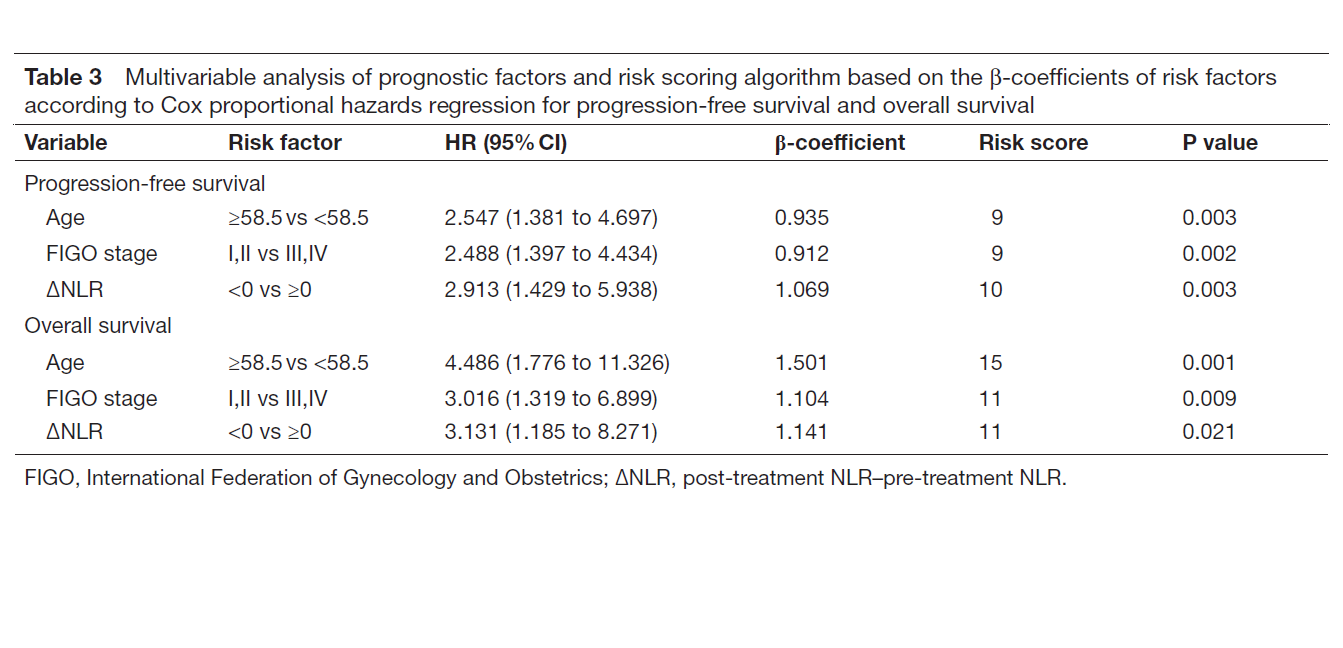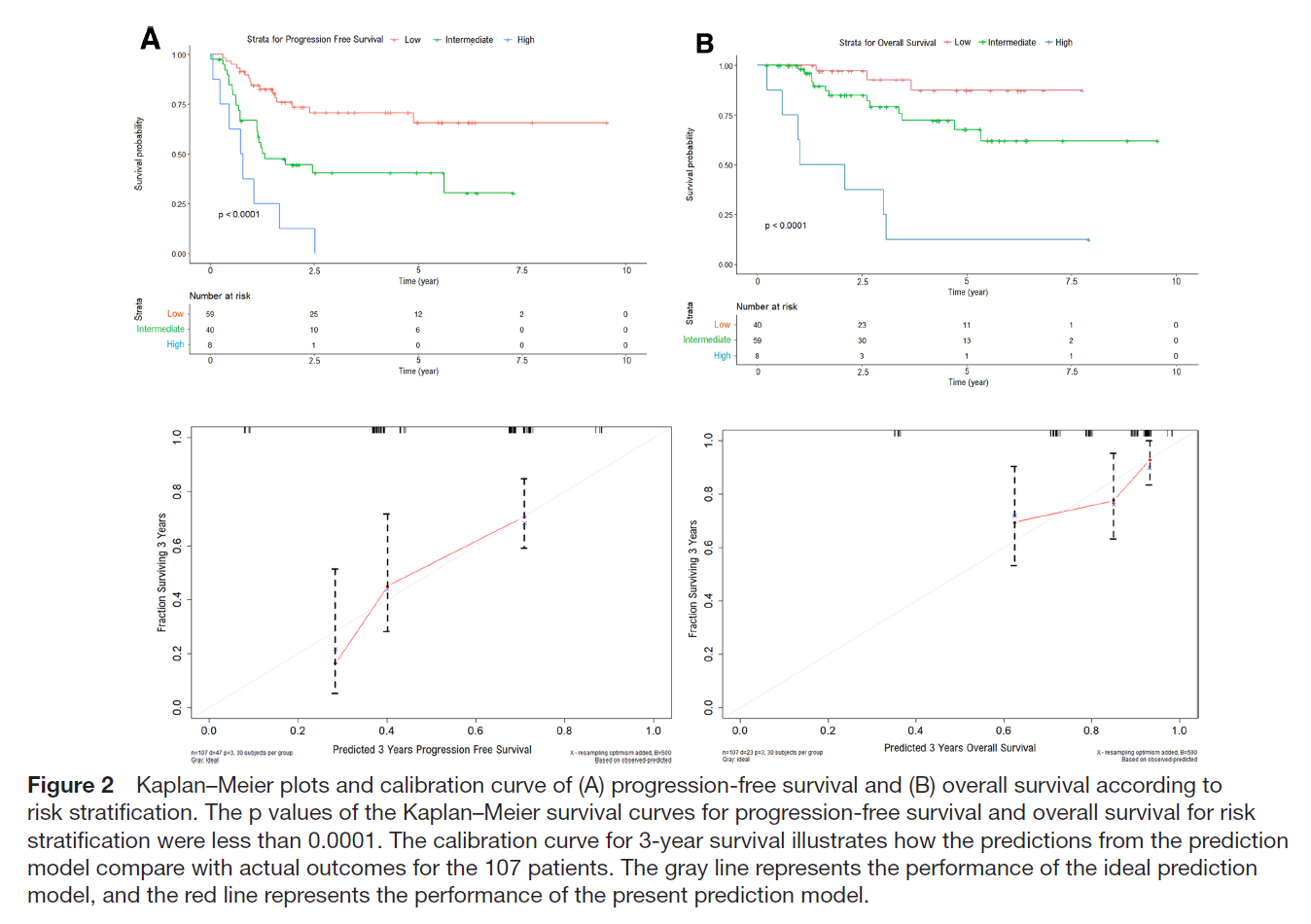글로벌 연구동향
방사선종양학
- 2021년 01월호
[Int J Gynecol Cancer.] Prediction scoring system based on clinicohematologic parameters for cervical cancer patients undergoing chemoradiation가천의대 / 이석호
- 출처
- Int J Gynecol Cancer.
- 등재일
- 2020 Nov
- 저널이슈번호
- 30(11):1689-1696. doi: 10.1136/ijgc-2019-001050.
- 내용
Abstract
Objective: A scoring system based on clinicohematologic parameters in cervical cancer patients receiving chemoradiation has not been reported to date. The aim of this study was to determine the prognostic value of clinicohematologic parameters in patients with cervical cancer undergoing chemoradiation and to develop a prediction scoring system based on these results.Methods: A total of 107 patients who received definitive chemoradiation for cervical cancer were enrolled in this study. The clinical data and hematologic parameters were retrospectively reviewed, and their prognostic value in predicting survival was analyzed. The neutrophil-to-lymphocyte ratio (NLR), platelet-to-lymphocyte ratio (PLR), and lymphocyte-to-monocyte ratio (LMR) and the changes in these hematologic parameters (ΔNLR, ΔPLR, and ΔLMR) between pre- and post-treatment were calculated to determine the specific value of these parameters for predicting patient survival.
Results: The median follow-up time was 39.9 (range 2.7-114.6) months. The 3-year overall survival rate and progression-free survival rate were 80.9% (95% CI 72.7 to 90.0) and 53.4% (95% CI 44.1 to 64.8), respectively. The median progression-free survival was 67.5 months and the median overall survival was not reached. According to multivariable analysis, a ΔNLR≥0 was significantly associated with decreased progression-free survival (HR=2.91, 95% CI 1.43 to 5.94) and overall survival (HR=3.13, 95% CI 1.18 to 8.27). In addition, age (age <58.5 years; progression-free survival: HR=2.55, 95% CI 1.38 to 4.70; overall survival: HR=4.49, 95% CI 1.78 to 11.33) and the International Federation of Gynecology and Obstetrics (FIGO) stage (Ⅲ-Ⅳ; progression-free survival: HR=2.49, 95% CI 1.40 to 4.43; overall survival: HR=3.02, 95% CI 1.32 to 6.90) were identified as predictors of poor survival.
Conclusions: Both the age and FIGO stage, as clinical parameters, and the ΔNLR, as a hematologic parameter, were independent prognostic factors for survival for cervical cancer patients treated with chemoradiation. Based on these results, we developed a risk score-based classification system for predicting survival.


Affiliations
Youn Ji Kim 1 , Young Saing Kim 2 , Jin Woo Shin 3 , Biche Osong 4 , Seok Ho Lee 5
1 Gachon University College of Medicine, Incheon, Republic of Korea.
2 Division of Medical Oncology, Department of Internal Medicine, Gachon University Gil Medical Center, Incheon, Republic of Korea.
3 Department of Obstetrics and Gynecology, Gachon University Gil Medical Center, Incheon, Republic of Korea.
4 Department of Radiation Oncology (Maastro), GROW School for Oncology, Maastricht University Medical Centre+, Maastricht, The Netherlands.
5 Department of Radiation Oncology, Gachon University Gil Medical Center, Incheon, Republic of Korea souko@gilhospital.com.
- 키워드
- cervical cancer; radiotherapy.
- 연구소개
- 방사선치료를 시행 받은 자궁경부암환자를 대상으로 임상적 인자들과 함께 혈액학적 인자들을 바탕으로 생존율 및 무병생존율에 영향을 미치는 유의한 독립인자를 분석한 연구입니다. 분석결과 기존에 유의하다고 알려져 있던 임상적 인자들 외 혈액학적 인자 (delta NLR)도 생존율 및 무병생존율에 유의한 독립인자임을 확인할 수 있었습니다. 따라서, 실제 진료영역에서 의료진들에게 치료방침 및 예후를 예측하는데 도움을 될 만한 정보라 생각합니다.
- 덧글달기
- 이전글 [Strahlenther Onkol.] Impact of intracavitary brachytherapy technique (2D versus 3D) on outcomes of cervical cancer: a systematic review and meta-analysis
- 다음글 [Eur J Surg Oncol.] Survival benefit of adjuvant chemoradiotherapy for positive or close resection margin after curative resection of pancreatic adenocarcinoma







